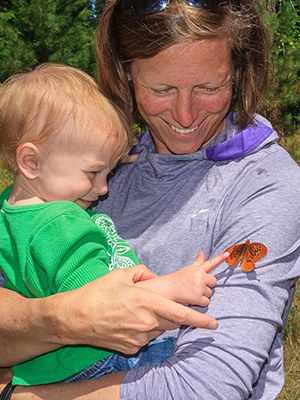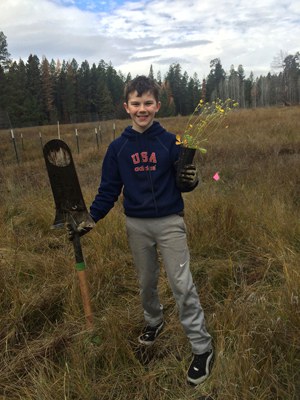
Study after study has shown that kids today don’t spend enough time outside. One recent study even noted that children worldwide now spend less time outside than the average prison inmate! Spending time in nature is a fundamental part of the human experience, so how do we change this trend for our children and grandchildren? Be their guide! Encourage them to explore and develop a sense of wonder in nature so they can one day help nature thrive. Don’t have kids or grandkids? Borrow a couple! We need to change this trend so the natural world has a future. Here’s how you can help.
- The first step is to get outside regularly to play together—more often than annual camping trips or school field trips. This doesn’t mean you have to craft fancy trips to tropical places to study endangered species. Go really local. Play outside in your backyard, your local dirt pile, or empty lot. Explore what makes your backyard yours. This is especially important in early childhood (2-6ish) when developmentally children need only to explore the “outside” that is within the comfort of home. They feel safe and brave because they know this world and you are close by to help them explore. Together you can make fairy houses out of pine needles and bark, float leaf boats on puddles, plant seeds, dig tunnels, get comfortable being and playing outside. You can even give over a section of your yard to your kids. Let them collect the flotsam and jetsam of life and build forts with it. One messy corner can be the springboard for worlds of wonder for your children.
- The second step, as your children grow, is to move from your yard to explore wild places near home. We are so fortunate in Central Oregon to have nature very nearby—even in our city parks and playgrounds. On your daily walks to the park or playground take some time explore the wild side of a park with your children. You may not notice it now, but many of your favorite parks have (intentionally or not) places where little bits of nature flourish. My family’s favorite “playground” is a local park with no play structures but rather perfect trees for climbing, lava rock piles for exploring, and space for roaming free and untethered.
Whatever your wild side, take the time to intentionally explore these areas regularly with your children. Be their guide in nature. I think as our children get older and start to ask more questions we get nervous that we don’t know all the answers. We feel like we have to be a biologist to be a good nature guide, right? Wrong. You don’t have to know all the answers, but rather you need to help them notice the little things, ask the right questions, and then find the answers together. What does a ponderosa pine smell like on a warm day? Why does it smell like that? Will lava rock float or sink? Why? - Next, when you’re ready to venture beyond your neighborhood, visit a local nature preserve or natural area on your own or on a guided walk. The Land Trust’s Indian Ford Meadow Preserve and Camp Polk Meadow Preserve are perfect kid-sized natural areas. They offer short trails and lots of interesting places to explore and see nature nearby. If you want to learn some tricks from some seasoned nature guides, the Land Trust also offers a variety of guided nature walks just for kids! Bird walks give kids a chance to walk like herons, and butterfly walks a chance to see fluttery creatures up close. Regardless of what outing you join, watch how the naturalists lead your kids. How do they encourage exploration and discovery? Which tricks can you try when you’re out next? Then, go try them on your next trip!
 A young volunteer helps plant at Spring Creek. Photo: Land Trust.
A young volunteer helps plant at Spring Creek. Photo: Land Trust. - Finally, as your children get older, give them a chance to give back to nature. Volunteer for work parties at parks and natural areas. Sign up care for a plot of land. Pick up garbage or pull weeds. Put a shovel or loppers in their hands and let them make a difference so they can see the impact.
Connecting your children to nature can be a fun journey for the whole extended family. While it doesn’t have to be in exotic wild places, it does have to be intentional and often and with a guide—the best one, a parent, grandparent, or other caregiver. Together we can help our children explore nature, learn about nature, and one day hopefully work to protect it.
Learn more:
- Join the Land Trust for a guided walk for kids.
- Volunteer with the Land Trust.
- Check out Camp Polk Meadow Preserve for your visit.
- Check out Indian Ford Meadow Preserve for your visit.


